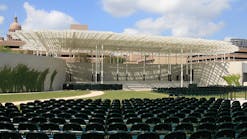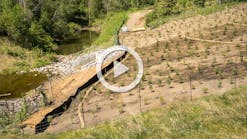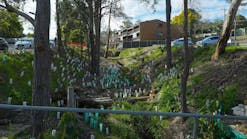Hydroseeding work, like all outdoor jobs, can have some unpleasant aspects. The weather can be perfect and then turn miserably cold or blisteringly hot. Working in the back country, far off road, increases the chances of encountering mountain lions, rattlesnakes, or other creatures best avoided. And if it’s hot and humid, the mosquitoes are almost certain to show up.
One of the advantages of hydroseeding work, though, is the variety of projects it offers. The clients, terrain, surroundings, weather, difficulty, and challenges are different on each project. Choosing the best seed, mulch, tackifier, and other ingredients to stop erosion and revegetate land makes for interesting work, as the following hydroseeding projects show.
“There are different ways to do hydroseeding. Our favorite way aligns with DOT [Department of Transportation] specifications,” says Toby Watters, of Dresden Landscaping in Dresden, OH.
The Dresden Landscaping hydroseeding crew members “apply fertilizer, lime, and seed mixture in a slurry, with a little mulch, using a hydroseeding machine. Then we apply a good straw mulch. Then we use the machine to apply a blanket of tackifier mixed with hydromulch,” Watters explains.
Dresden Landscaping relies on three Bowie hydroseeding machines. Two are 1,100-gallon Vector models, and one is a 1,500-gallon Imperial model.
“Bowies are very reliable. They do a great job for us,” says Watters.
“Some of our most challenging projects are power plant landfill jobs,” he notes. “We often have to put our equipment behind bulldozers.”
One such job is for the American Electric power plant in Rockport, IN. Dresden Landscaping crews started working there since 2012 and will finished in spring 2014.
“We did about 180 acres in total,” Watters says. “They have 20 to 25 acres ready for us to hydroseed each time. We do three mobilizations a year.”
On the sections of flat, open ground, a crew can finish 6 to 7 acres per day. Where the terrain is rougher and the slopes are steeper, the crew covers about 3 to 4 acres per day.
“We send a foreman and a crewman and pull additional laborers from the local union hall,” Watters says. “We’re [working] under the hall maintenance policy committee.”
Because this job is completely off the road, the Dresden crew uses a smaller Bowie, a 1,100-gallon Vector model. It gives better access than the larger model. The job “is a true reclamation project. There’s more concern with getting it stabilized, so they’re not picky about seeding windows,” Watters says.
For seeding, the crew applies a reclamation mix. “It’s a turf plant mix, mostly fescues, with some perennial ryes, and a little bluegrass,” Watters says. Usually, the crew will add a nurse crop of seeds to help the vegetation get established quickly, using clover, annual ryegrass, or winter wheat, which will germinate at a lower temperature.
For soil amendments, Watters likes to use dry lime, at the rate of 2 tons per acre. He applies starter fertilizer, 15-30-15, at the rate of 600 pounds per acre.
To improve results, he says, “We use straw blowers made by Reinco. We’ll put down 10 tons of straw per hour. We go through 500 to 600 bales of straw per day.” A tackifier mixed with hydromulch keeps the straw in place. The crew doesn’t work if the day is windy.
The most challenging part of the American Electric power plant project is the straw blowing, he says. “It is labor-intensive. The guys are handling a lot of straw from the truck, feeding the blower,” Watters explains.
As for anything unexpected on the project, Watters says, “In southeast Ohio and West Virginia we’re not accustomed to mostly flat terrain, so we were pleasantly surprised.”
A horticulturist by training, Watters joined Dresden 22 years ago. “Then the company was doing small erosion control projects, such as around bridges, and general landscaping. We found there was a market for commercial and industrial erosion control and hydroseeding,” he says.
The company now has two divisions. Dresden Land Work now does nonunion work, and Dresden Landscaping handles large projects that require employing union workers.
Hydroseeding on Campus
Farther east from Dresden, James Madison University sits on 850 acres of land in Harrisonburg, in northern Virginia. The campus has a rolling terrain.
“We have lots of hills and some steep slopes,” says Frank Lucas. “We use a Finn T-120 HydroSeeder to overseed our banks and on slopes.”
Lucas and his crew at James Madison keep their HydroSeeder in use from spring through fall. Besides the typical uses related to landscaping, they have found an unusual way to save money with their machine.
Employees at James Madison-like those at most universities in these uncertain economic times-look for ways to reduce operating costs. They also work at making their university more sustainable. Lucas’s boss lamented the fact that so much water was wasted when his employees tested the fire sprinkler systems in campus buildings, as state law required them to do on a biweekly basis. The cost of the wasted water, which gushed onto the ground outside of each building, was not the only problem.
“It was causing erosion problems for us, washing out the mulch around plants and the grass,” Lucas explains.
So the James Madison crew connected the hose of the HydroSeeder to the sprinkler system’s outlet pipe and used the heretofore wasted water as a new, free source for irrigating landscaping on campus. Their experiment, begun last summer, has worked well.
“It takes about five to 10 minutes to fill the HydroSeeder, and then we drive it on a trailer to where we don’t have an irrigation system and spray the plants,” Lucas says. The HydroSeeder makes it easy to fill the water storage bags attached to trees around campus.
The first summer, the crew worked with the sprinkler systems in about nine buildings. Next summer the company plans to do this campuswide and also wants to add water used during the required testing of fire hydrants, which are on a different line.
The James Madison landscaping crew also uses the HydroSeeder to wash down sidewalks and streets. It’s especially useful in areas of campus where construction and remodeling projects are going on.
Renovating a Golf Course
A project across the country done by Pacific Rim Hydroseeding is another example of the variety of hydroseeding work. Don Smith and Cory Streblow are co-owners of Pacific Rim, which is located in Valley Center, CA, about 50 miles from San Diego.
From late August to late November 2013, Smith spent a lot of time in northern California near San Francisco. Pacific Rim did the hydroseeding work on the renovation of the Menlo Country Club’s golf course in Woodside.
The golf course has the standard 18 holes, plus a driving range. The total area involved was about 100 acres, and the project was a complete renovation of the course. The club was built more than 100 years ago. Twenty-five years had elapsed since its golf course had been renovated.
The soil beneath the fairways was clay, which made it difficult to keep grass growing well enough to provide the desired lush green look that golf courses are expected to have. The first step was to put down a sand cap, a 6-inch layer of sand on the fairways.
“Then we seeded the fairways with a special blend of ryegrasses. On the roughs we used a hard fescue blend. It grows about a foot tall and has a nice windblown look to it,” Smith says. “No nurse crop seed was needed.”
The golf course managers wanted to use the blend of native fescues for an additional reason. These grasses require less water, thus being environmentally friendly and also saving operating costs.
To go with the seed, “we specified a wood fiber mulch-we don’t like using paper-made by Applegate in North Carolina. It’s made from poplar so it has long strands that work well for controlling erosion. Also in the mix is a plantago husk binder, a type of psyllium. That’s Indian wheat grass which grows in India and Pakistan,” Smith adds.
The roughs of the golf course-all sloped areas-required more detail work. They also got more binder applied, as did the sand traps. The crew used Rantec’s SpecTac as the tackifier.
When Smith saw that some of the project managers had specified using bonded fiber matrix on the steeper slopes of the golf course, “I told them they would be wasting their time because all the slopes are irrigated. Bonded fiber matrix is the “˜golden child’ of erosion control, but it’s designed for nonirrigated areas, places with native plants that depend on rain.”
To get the work done, Pacific Rim’s two-man crew relied on a Bowie 1,100-gallon hydroseeding machine. They pulled it around on a 550 flatbed trailer.
“It’s a good size piece of equipment. Bowie makes a real desirable hydroseeding machine. It’s like part of our toolbox,” Smith says.
The hardest part of the job was “actually getting to some of the area so we could work. Once they sandcapped a fairway, we couldn’t drive across it. The guys were putting in a car path, but we couldn’t drive on that either. Coordinating our work with other work being done was sometimes tricky,” Smith says.
As for the weather during work time on the golf course, “it’s been phenomenal,” Smith says. “We’ve been so lucky. We’ve had Indian summer, with 72-degree days and 50s at night.”
Smith has been in hydroseeding work since 1977. “Cory and I worked together for another company for over 20 years. We decided to start our own company in 2006.”
Onandaga Lake
Phil Ciaramella of Lawn Tech in Lafayette, NY, is doing hydroseeding work on a huge project in Syracuse (Onandaga County), NY. The project is the restoration of Onandaga Lake, which borders downtown Syracuse, separated by a major thoroughfare.
Ciaramella says the $1 billion cleanup operation is so large that, for a time, work was going on 24 hours a day. Honeywell Corp., which merged in 1999 with a company that was responsible for polluting the lake, is working under a consent decree from EPA to remove pollution from the lake and surrounding area.
The project has been so well publicized, and so many local organizations have been monitoring the lake’s deteriorating condition, that residents are very interested in the cleanup.
To keep them informed about different stages of the work, Honeywell has set up a visitors’ center near the site.
Various Native American tribes were drawn to Onandaga Lake and lived along its shores. After the area was settled by European immigrants and the city of Syracuse grew, the lake became the center of a resort area, ringed with hotels.
But as industry developed and the city grew in size and population, Onandaga Lake gradually became polluted from chemical and industrial wastes and sewage. By 1940, the heyday of the resort area was over. Most of the hotels had closed. and swimming was prohibited. Beginning in 1972, fishing in the lake was no longer allowed.
Ciaramella began doing hydroseeding work on the lake cleanup project about three years ago. The work will continue for at least another few years, and it’s varied. “There’s everything from sheer drop-offs to wide open flat areas,” he explains.
For this project and others, he uses a C-170 hydroseeding machine made by Epic Manufacturing of Delaware. Its capacity is 1,700 gallons.
Along with the seed, Ciaramella uses a 70/30 wood and paper hydromulch. “Some areas get Flexterra. There are a lot of ditch-like areas,” he says.
Ciaramella started doing hydroseeding work about 12 years ago with a small machine. “I worked for another construction company for about five years. Then I got a bigger machine and used it for five years. Then I got what I have now,” he says.
His favorite type of hydroseeding job is “probably the real technical stuff-where there’s a lot of elevation and the mixture has to be just right-the challenging stuff. Spraying flat fields gets boring sometimes,” he says.
Working with Ciaramella is ecologist and plant specialist Tony Eallanardo of O’Brien and Gere, a design-build engineering firm that is also part of the Onandaga Lake cleanup project.
“We’ve restored an embankment along the roadway, cleared invasive species. It’s a highly visible area. We have a three-acre meadow restored with native grasses and wildflowers. The asters and goldenrods are blooming,” Eallanardo says.
Along with seeding native species of cool-season grasses, nurse crop seeds are being added. “We use either oats or annual ryegrass. The rye is too aggressive to use except in some instances-only where the slopes are very steep,” says Eallanardo.
Eallanardo also likes to use the Flexterra on the steepest slopes. “We applied it at 2,000 pounds per acre,” he says.
Ellanardo and Ciaramello have done some experimenting. “We’ve been trying different mulches and different seed mixes,” Ellanardo says.
The lake cleanup effort has inspired some other experimentation, which has produced a new way to deal with mercury. Reducing the amount of it in the lake and lake bed is a major concern of this project because of its high toxicity.
By 2015, dredging machines will remove more than 2 million cubic yards of contaminated muck from Onandaga Lake. Then more than 450 acres of the lake bottom will be sealed with a 3-foot layer of sand and dirt. Another part of the restoration is the creation of wildlife habitats along Nine Mile Creek and Geddes Brook.
Engineers and scientists at Honeywell and the New York Department of Environmental Conservation decided that capping and dredging were the best ways to clean up areas near shore. However, these strategies would not work for most of the lake because it’s too big (4.5 square miles) and too deep (up to 68 feet at its deepest section).
Early studies of Onondaga Lake showed that keeping a particular form of mercury called methylmercury out of the water would be essential if the levels of mercury in fish were to be reduced. Most of the methylmercury is in the sediments in the deep areas of the lake and can float up to be ingested by fish.
Experimentation suggested that if workers could find a way to coat the bottom of Onondaga Lake with a common fertilizer-calcium nitrate-the methylmercury would stay within the sediment on the bottom.
The calcium nitrate is added in summer because that’s when the lake has warmer water atop cold water. The calcium nitrate gets to the bottom layer and spurs the growth of a type of bacteria that overwhelms the bacteria that creates methylmercury. Calcium nitrate also helps the mercury bind to iron in the bottom muck.
The unusual strategy that many people considered too bizarre to try has proven to be a success. Coating the lake bottom with calcium nitrate has cut mercury levels in the water by an amazing 95%.
Of this major environmental project on Onandaga Lake, Ellanardo says, “We’re all excited by the opportunity to give something positive back to the community-not only the cleanup of the lake, but also to create wildlife habitat.”
Wind Farms
There’s a line in the title song of Rodgers and Hammerstein’s Oklahoma!: “where the wind comes sweeping down the plain.” Not surprisingly, wind energy farms are being built in Oklahoma and in northern Texas. That alternative source of energy means work for hydroseeding companies.
Josh Rapp of Tallgrass Environmental Solutions in Arcadia, OK, and Marcus Reed of Reed Hydromulching, based in Dallas-Ft. Worth, TX, are the owners of two such companies. They joined forces to do the hydroseeding at two wind farms.
The two men have also done other hydroseeding projects together. Both of them use Finn HydroSeeders.
The Blue Canyon wind farm is in the Slick Hills of southwest Oklahoma, near the Wichita Mountains. The Senate wind farm is in north Texas, near the Red River, southwest of Wichita Falls. Work at Blue Canyon covered about 110 acres, while the larger Senate job involved about 200 acres.
The Senate site was planted almost entirely by drill seeder, with a little bit of hydroseeding on steep slopes, a couple of cut banks and fill banks. The work at Blue Canyon was all done by hydroseeding.
“It’s super rocky, super steep, super rough,” Rapp says. “We used Second Nature wood fiber blend and a guar tackifier. We seeded grasses native to a short grass prairie. That includes buffalo grass, blue grama, side oats grama, and green sprangletop.”
A nurse crop is essential because the locations of the farms are windy, hot, and dependent on rain for moisture. Rapp likes to use oats, wheats, or a combination of the two for cool-season nurse crops. For nurse seeding during hotter months, he favors German brown millet.
“The green sprangletop is a native grass and we use it sometimes as a cover crop. It germinates quickly. It’s a decreaser-it does really well for the first year and then begins disappearing,” Rapp says.
An above-average amount of rain fell in the region in 2013, but the general lack of moisture affected seed choices and time of planting. “We’re still included in the exceptional drought conditions, as judged by the US Weather Service,” Rapp explains.
He adds that sometimes when clients want hydromulch to be used on their projects, “we can’t get the water to hydromulch. Cities are under water restrictions and can’t sell water.”
Another regional factor is the high wind. “It affects how we plant,” Rapp says. “We’ve been shut down when the wind was just too strong to plant.”
To protect seed from being blown away, Rapp added a wind guard to the Great Plains No. 711 seed driller he uses. The seed in the native grass box is stirred by an agitator, so that it slides down a tube and falls into furrows that the planter makes in the soil.
“There’s a little gap between the end of the tube and the soil-only about three inches-but the native seed can dang sure blow away if the wind is blowing 20 miles per hour, so we put on a sleeve with zip ties,” Rapp says.
Tallgrass Environmental specializes in native grasses and native plants. The company has done work in Missouri and Arkansas.
“Ninety percent of our work is in north Texas, Oklahoma, and Kansas,” Rapp says. “We plant year around, dictated by the clients’ schedules or contractors’ schedules.”
Hydroseeding can be difficult and challenging work, dangerous at times. But as these projects suggest, it’s also interesting and varied.






